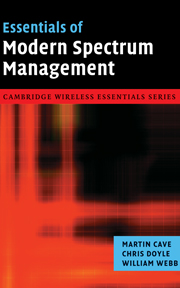Book contents
- Frontmatter
- Contents
- Acknowledgements
- I Emerging problems with the current spectrum management approach
- II Markets
- III Regulation
- 11 Incentive based spectrum prices: theory
- 12 Incentive based spectrum pricing: practicalities
- 13 How the commons works
- 14 Commons or non-commons?
- 15 Is public sector spectrum management different?
- 16 Are developing countries different?
- IV Conclusions
- Further reading
- Abbreviations
- Author biographies
- Subject index
- References
15 - Is public sector spectrum management different?
Published online by Cambridge University Press: 13 August 2009
- Frontmatter
- Contents
- Acknowledgements
- I Emerging problems with the current spectrum management approach
- II Markets
- III Regulation
- 11 Incentive based spectrum prices: theory
- 12 Incentive based spectrum pricing: practicalities
- 13 How the commons works
- 14 Commons or non-commons?
- 15 Is public sector spectrum management different?
- 16 Are developing countries different?
- IV Conclusions
- Further reading
- Abbreviations
- Author biographies
- Subject index
- References
Summary
Introduction
Spectrum is used to produce services which are supplied by firms for commercial reasons and distributed into a market place, and to provide public services such as defence and emergency services which are usually provided free at the point of delivery by a public body.
In the UK public sector spectrum use accounts for just under half of all spectrum use below 15 GHz – this represents the vast bulk of valuable frequencies. The breakdown of public sector spectrum use is shown in Figure 15.1.
In other countries too, military use of spectrum, particularly for radar and communications, accounts for most of public sector use. In the presence of international military alliances, such as NATO, military spectrum allocations are often harmonised internationally.
In most jurisdictions, commercial and public sector spectrum allocations are managed in a broadly similar way by the same independent agency or government department. A major exception is the United States, where spectrum used by the Federal Government is managed by the National Telecommunications and Information Administration (NTIA), part of the Department of Commerce, while spectrum allocated for commercial purposes and to state and local government is managed by the independent communications regulator, the Federal Communications Commission (FCC). Any major transfer or re-alignment of spectrum use may face the additional handicap of negotiations between these two organisations.
Historically, public sector organisations, especially national defence departments, were accorded high priority in spectrum use. Under the command-and-control regime, they were allocated spectrum for an indefinite period.
- Type
- Chapter
- Information
- Essentials of Modern Spectrum Management , pp. 231 - 238Publisher: Cambridge University PressPrint publication year: 2007



